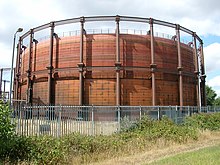Gas holder: Difference between revisions
No edit summary |
No edit summary |
||
| Line 1: | Line 1: | ||
[[Image:Lazarus Thick Shell Gasholder.jpg|thumb|right|BF Gasholder at [[Ruukki Steel in Finland]].]] |
[[Image:Lazarus Thick Shell Gasholder.jpg|thumb|right|30,000m3 BF Gasholder at [[Ruukki Steel in Finland]].]] |
||
[[Image:Gasometer in East London.jpg|thumb|right|Gasometer at [[West Ham]].]] |
[[Image:Gasometer in East London.jpg|thumb|right|Gasometer at [[West Ham]].]] |
||
[[Image:Gasholders at the Oval.JPG|thumb|right|The famous Gasometers at [[The Oval]].]] |
[[Image:Gasholders at the Oval.JPG|thumb|right|The famous Gasometers at [[The Oval]].]] |
||
Revision as of 22:58, 11 September 2008




A gasometer, or gas-holder, is a large container where natural gas or town gas is stored near atmospheric pressure at ambient temperatures. The volume of the container follows the quantity of stored gas, with pressure coming from the weight of a movable cap. Typical volumes for large gasometers are about 50,000 m³, with 60 m diameter structures. Gasometers tend to be used for balancing purposes (making sure gas pipes can be operated within a safe range of pressures) rather than for actually storing gas for later use. Gas more recently was stored in large underground reservoirs such as salt caverns. Nowadays however line-packing is the preferred method.
Lazarus & Associates Ltd in the UK are the foremost experts in design & operation of gasholders http://www.lazarusandassociates.com with particular reference to Dry Seal Type as used in the iron & steel industry for storage and delivery of Blast Furnace & BOS / LD/ BOF Gases from the Iron & Steel Making Process.
Throughout the 1960s and 1970s it was thought that gasholders could be replaced with high pressure bullets. However, regulations brought in meant that all new bullets must be built several miles out of towns and cities and the security of storing large amounts of high pressure natural gas above ground made them unpopular with local people and councils. Bullets are gradually being decommissioned. It is also possible to store natural gas in a liquid form and is widely practiced throughout the world.
Gasholders hold a large advantage over other methods of storage. They are the only storage method which keeps the gas at district pressure. Once the District Low Pressure Switch falls and the booster fans come on, the gas in these holders can be at homes, being used in a very short space of time. Gas is stored in these throughout the day when little gas is being used. At about 5pm there is a great demand for gas and the holder will come down, supplying the district.
There are two basic types of gasholders, rigid waterless and telescoping. Rigid waterless gas holders were a very early design which outwardly showed no sign of expansion or contraction. Telescoping holders fall into two subcategories. The earlier of the telescoping variety were column guided variations and were built in Victorian times In order to guide the telescoping lifts they have an external fixed frame, visible at a fixed height at all times. Spiral guided gasholders were built in the UK up until 1983. These have no frame and each lift is guided by the one below, rotating as it goes up as dictated by helical runners. Both telescoping types use the manometric property of water in order to provide a seal.
Gasometers are often a major part of the skylines of low-rise British cities, due to their large distinctive shape and central location. The pollution associated with gasworks and gas storage makes the land difficult to reclaim for other purposes, but some gasometers, notably in Vienna, have been converted into living space and shopping mall.
Most British cities will have several gasholders. London, Birmingham, Manchester, Sheffield, Leeds, Newcastle and Glasgow (which has the largest gasometers in the UK[1]) are noted for having many gasholders. Some of these gasometers have become listed buildings. In the past holder stations would have an operator living on site controlling their movement. However with the process control systems now used on these sites, such an operator is obsolete.The tallest gasometer in europe is found in Rome, at ostience next to the Tevere river, the gasometer is 92 meters tall.
The term gasometer was originally coined by William Murdoch, the inventor of gas lighting, in the early 1800s. Despite the objections of his associates that his so-called "gazometer" was not a meter but a container, the name was retained and came into general use. The word is also used to describe a meter for measuring the amount of gas flowing through a particular pipe.



See also
External links
- Condemned: The great gasometer from BBC News, January 28, 1999
- Gasometer Oberhausen, Germany
- Gasometer Augsburg in Germany and a list of many Gasometers in Europe
- Gasometer Vienna, Austria
- Gasometer Schlieren, Switzerland
- The rise and fall of gasometers Extrageographic magazine
- Lazarus & Associates Ltd United Kingdom
References
-
Caption1
-
Caption2
</gallery>
-
Caption1
-
Caption2
</gallery>

